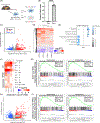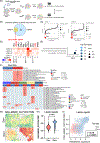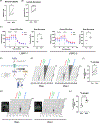Metabolic reprogramming by mutant GNAS creates an actionable dependency in intraductal papillary mucinous neoplasms of the pancreas
- PMID: 39277181
- PMCID: PMC12014225
- DOI: 10.1136/gutjnl-2024-332412
Metabolic reprogramming by mutant GNAS creates an actionable dependency in intraductal papillary mucinous neoplasms of the pancreas
Abstract
Background: Oncogenic 'hotspot' mutations of KRAS and GNAS are two major driver alterations in intraductal papillary mucinous neoplasms (IPMNs), which are bona fide precursors to pancreatic ductal adenocarcinoma. We previously reported that pancreas-specific Kras G12D and Gnas R201C co-expression in p48Cre; KrasLSL-G12D; Rosa26LSL-rtTA; Tg (TetO-GnasR201C) mice ('Kras;Gnas' mice) caused development of cystic lesions recapitulating IPMNs.
Objective: We aim to unveil the consequences of mutant Gnas R201C expression on phenotype, transcriptomic profile and genomic dependencies.
Design: We performed multimodal transcriptional profiling (bulk RNA sequencing, single-cell RNA sequencing and spatial transcriptomics) in the 'Kras;Gnas' autochthonous model and tumour-derived cell lines (Kras;Gnas cells), where Gnas R201C expression is inducible. A genome-wide CRISPR/Cas9 screen was conducted to identify potential vulnerabilities in KrasG12D;GnasR201C co-expressing cells.
Results: Induction of Gnas R201C-and resulting G(s)alpha signalling-leads to the emergence of a gene signature of gastric (pyloric type) metaplasia in pancreatic neoplastic epithelial cells. CRISPR screening identified the synthetic essentiality of glycolysis-related genes Gpi1 and Slc2a1 in Kras G12D;Gnas R201C co-expressing cells. Real-time metabolic analyses in Kras;Gnas cells and autochthonous Kras;Gnas model confirmed enhanced glycolysis on Gnas R201C induction. Induction of Gnas R201C made Kras G12D expressing cells more dependent on glycolysis for their survival. Protein kinase A-dependent phosphorylation of the glycolytic intermediate enzyme 6-phosphofructo-2-kinase/fructose-2,6-biphosphatase 3 (PFKFB3) was a driver of increased glycolysis on Gnas R201C induction.
Conclusion: Multiple orthogonal approaches demonstrate that Kras G12D and Gnas R201C co-expression results in a gene signature of gastric pyloric metaplasia and glycolytic dependency during IPMN pathogenesis. The observed metabolic reprogramming may provide a potential target for therapeutics and interception of IPMNs.
Keywords: gastric metaplasia; glucose metabolism; oncogenes; pancreatic cancer; pre-malignancy - GI tract.
© Author(s) (or their employer(s)) 2025. No commercial re-use. See rights and permissions. Published by BMJ Group.
Conflict of interest statement
Competing interests: AM is listed as an inventor on a patent that has been licensed by Johns Hopkins University to Thrive Earlier Detection. AM serves as a consultant for Tezcat Biosciences.
Figures







References
-
- Landis CA, Masters SB, Spada A, Pace AM, Bourne HR, Vallar L. GTPase inhibiting mutations activate the alpha chain of Gs and stimulate adenylyl cyclase in human pituitary tumours. Nature 1989;340:692–6. - PubMed
MeSH terms
Substances
Grants and funding
LinkOut - more resources
Full Text Sources
Medical
Molecular Biology Databases
Miscellaneous
